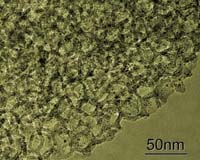 |
Washington DC (SPX) Dec 01, 2010 One of the holy grails of nanotechnology in medicine is to control individual structures and processes inside a cell. Nanoparticles are well suited for this purpose because of their small size; they can also be engineered for specific intracellular tasks. When nanoparticles are excited by radio-frequency (RF) electromagnetic fields, interesting effects may occur. For example, the cell nucleus could get damaged inducing cell death; DNA might melt; or protein aggregates might get dispersed. Some of these effects may be due to the localized heating produced by each tiny nanoparticle. Yet, such local heating, which could mean a difference of a few degrees Celsius across a few molecules, cannot be explained easily by heat-transfer theories. However, the existence of local heating cannot be dismissed either, because it's difficult to measure the temperature near these tiny heat sources. Scientists at Rensselaer Polytechnic Institute have developed a new technique for probing the temperature rise in the vicinity of RF-actuated nanoparticles using fluorescent quantum dots as temperature sensors. The results are published in the Journal of Applied Physics. Amit Gupta and colleagues found that when the nanoparticles were excited by an RF field the measured temperature rise was the same regardless of whether the sensors were simply mixed with the nanoparticles or covalently bonded to them. "This proximity measurement is important because it shows us the limitations of RF heating, at least for the frequencies investigated in this study," says project leader Diana Borca-Tasciuc. "The ability to measure the local temperature advances our understanding of these nanoparticle-mediated processes."
Share This Article With Planet Earth
Related Links American Institute of Physics Nano Technology News From SpaceMart.com Computer Chip Architecture, Technology and Manufacture
 Cinnamon Can Replace Harmful Chemicals Used To Create Nanoparticles
Cinnamon Can Replace Harmful Chemicals Used To Create NanoparticlesColumbia MO (SPX) Dec 01, 2010 Gold nanoparticles, tiny pieces of gold so small that they can't be seen by the naked eye, are used in electronics, healthcare products and as pharmaceuticals to fight cancer. Despite their positive uses, the process to make the nanoparticles requires dangerous and extremely toxic chemicals. While the nanotechnology industry is expected to produce large quantities of nanoparticles in the n ... read more |
|
| The content herein, unless otherwise known to be public domain, are Copyright 1995-2010 - SpaceDaily. AFP and UPI Wire Stories are copyright Agence France-Presse and United Press International. ESA Portal Reports are copyright European Space Agency. All NASA sourced material is public domain. Additional copyrights may apply in whole or part to other bona fide parties. Advertising does not imply endorsement,agreement or approval of any opinions, statements or information provided by SpaceDaily on any Web page published or hosted by SpaceDaily. Privacy Statement |